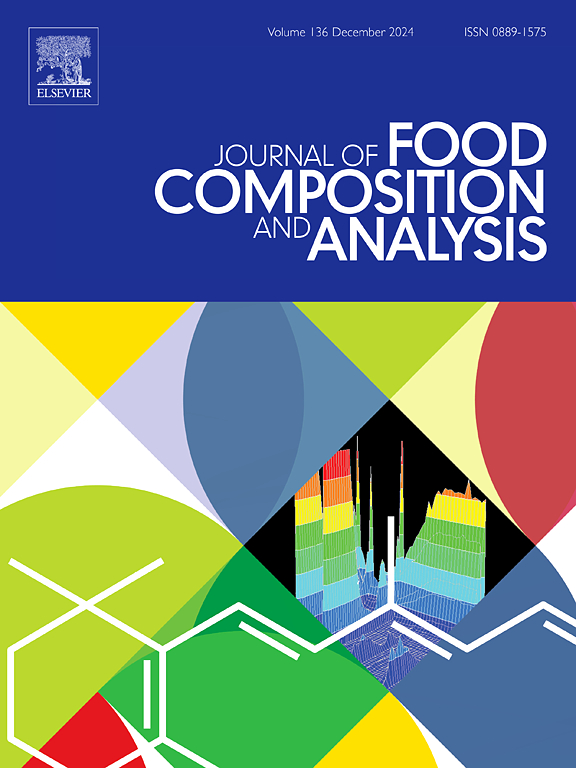不同预处理条件下龙眼多糖的理化、结构和功能特性的比较研究
IF 4.6
2区 农林科学
Q2 CHEMISTRY, APPLIED
引用次数: 0
摘要
多糖是龙眼中主要的生物活性成分;然而,干燥前的预处理对其性能的影响尚不清楚。本研究比较了鲜龙眼多糖(fresh - p)、未预处理和干燥龙眼多糖(CK-P)和经焯水(BL-P)、超声(US-P)、冻融(FT-P)和射频(RF-P)预处理的龙眼多糖的理化、结构和功能特性。结果表明,US-P的总糖含量(70.25 %)、醛酸含量(19.48 %)和粒径(180.80 nm)最高,多酚含量(0.42 %)、蛋白质含量(0.45 %)、分子量(1.95 ×104 Da)和表观粘度最低。与CK-P相比,BL-P和US-P表现出不同的表面形态。傅里叶变换红外光谱(FT-IR)和刚果红测试结果表明,预处理对龙眼多糖的主要官能团和三螺旋结构没有显著影响。x射线衍射(XRD)分析表明,超声和焯水均能增强龙眼多糖的结晶状态。此外,FT-P表现出最高的抗氧化活性,而US-P表现出更强的益生菌活性。此外,US-P在龙眼多糖中具有较强的α-葡萄糖苷酶和α-淀粉酶抑制活性。这些发现有助于我们进一步了解预处理对龙眼多糖性质的影响,并为从多糖角度开发优质龙眼及其衍生物提供科学指导。本文章由计算机程序翻译,如有差异,请以英文原文为准。
Physicochemical, structural and functional properties of polysaccharides extracted from dried longan with different pretreatments: A comparison study
Polysaccharides are key bioactive compounds found in dried longan; however, the effects of pretreatments before drying on their properties remain unclear. The present study compared the physicochemical, structural and functional properties of polysaccharides derived from fresh longan (Fresh-P), unpretreated and dried longan (CK-P), and dried longan pretreated with blanching (BL-P), ultrasound (US-P), freeze-thaw (FT-P), and radio frequency (RF-P). Results indicate that US-P exhibited the highest total sugar (70.25 %), uronic acid (19.48 %) and particle size (180.80 nm), while the lowest levels of polyphenols (0.42 %), protein (0.45 %), molecular weight (1.95 ×104 Da), and apparent viscosity among dried longan polysaccharides. BL-P and US-P showed distinct surface morphologies when compared to CK-P. The pretreatments did not significantly alter the main functional groups or the triple helical structure of the longan polysaccharides according to Fourier transform-infrared spectroscopy (FT-IR) and the Congo red test. However, both ultrasound and blanching enhanced the crystalline state of the dried longan polysaccharides, as evidenced by X-ray diffraction (XRD) analysis. Furthermore, FT-P demonstrated the highest antioxidant activity, while US-P exhibited superior probiotic activity. Additionally, US-P presented relatively strong α-glucosidase and α-amylase inhibitory activities among the dried longan polysaccharides. Collectively, these findings enhance our understanding of how pretreatments affect the properties of longan polysaccharides and provided scientific guidelines for the development of superior dried longan and its derivatives from the perspective of polysaccharides.
求助全文
通过发布文献求助,成功后即可免费获取论文全文。
去求助
来源期刊

Journal of Food Composition and Analysis
工程技术-食品科技
CiteScore
6.20
自引率
11.60%
发文量
601
审稿时长
53 days
期刊介绍:
The Journal of Food Composition and Analysis publishes manuscripts on scientific aspects of data on the chemical composition of human foods, with particular emphasis on actual data on composition of foods; analytical methods; studies on the manipulation, storage, distribution and use of food composition data; and studies on the statistics, use and distribution of such data and data systems. The Journal''s basis is nutrient composition, with increasing emphasis on bioactive non-nutrient and anti-nutrient components. Papers must provide sufficient description of the food samples, analytical methods, quality control procedures and statistical treatments of the data to permit the end users of the food composition data to evaluate the appropriateness of such data in their projects.
The Journal does not publish papers on: microbiological compounds; sensory quality; aromatics/volatiles in food and wine; essential oils; organoleptic characteristics of food; physical properties; or clinical papers and pharmacology-related papers.
 求助内容:
求助内容: 应助结果提醒方式:
应助结果提醒方式:


